I hear some people say they are ‘templed out’ in Japan meaning they don’t want to visit any more of them but it’s not something I can relate to on a personal level. Temples and shrines are such an integral part of life in Japan that for each city or town you visit you can understand so much of its history and its people by wandering through the temples.
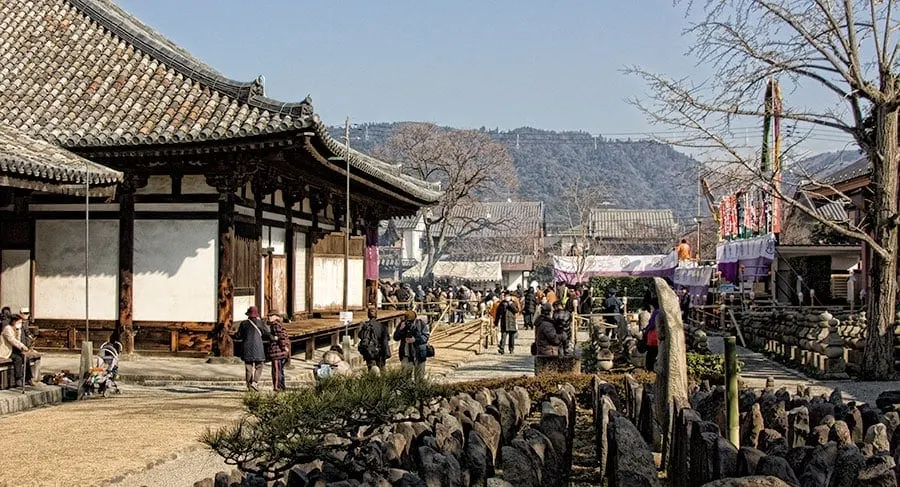
Gango-ji Temple is one of the seven great temples of Nara that existed in the Nara Period before the capital moved to Kyoto (Heian) in 795. In some ways Gango-Ji temple may not live up to the splendour of some of the other remaining temples from that period like Todai-Ji with its great Daibutsu, Kofuku-Ji with its tall pagodas and Horyu-Ji with its many treasures but having been cherished in its humble community for over 1,200 years makes Gango-ji temple truly worthy of its inclusion in this revered group and its protection as a UNESCO World Heritage site.
The temple is in the Naramachi district, an old merchant district of the town. Some of the machiya dating from the Edo period or slightly earlier have been preserved here. Machiya are long narrow townhouses that served a dual purpose as both a residence and place of business.
A few have been turned into museums and the area also has many cafes, restaurants and shops. Back in the 15th century much of the area they stand on would still have been the sprawling grounds of the temple but only a small part remains today.
We wandered around a bit first and detoured for a look at Kofuku-Ji and the lake but if you headed here directly the area would be about a 10-minute walk from the train station. If you wander up the main street away from the station you’ll come to the lake in front of you, Kofuku-ji is up the stairs to the left and you would head right from there to Naramachi.
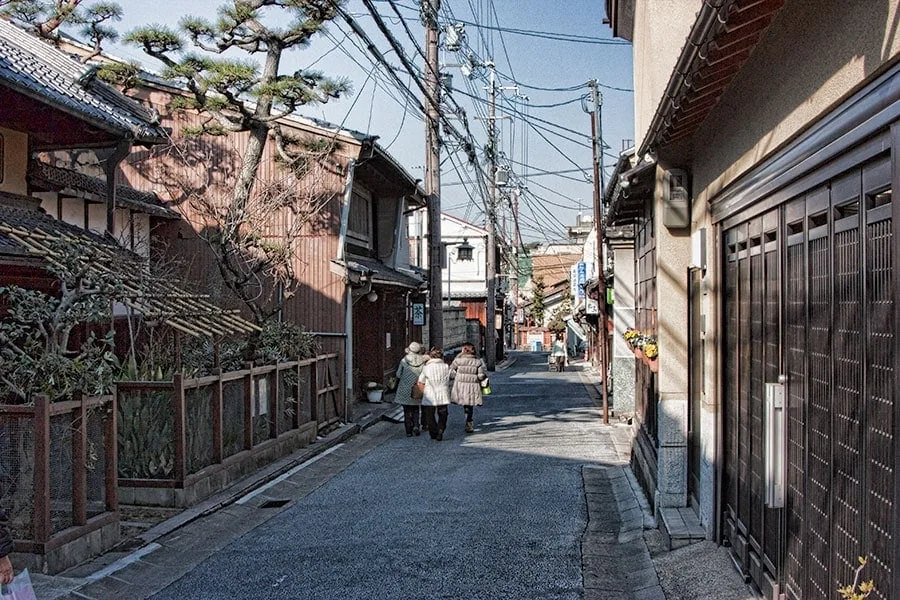
The reason Gango-ji holds such a special place in my heart is probably because we first visited during the Setsubun celebration when it was full of energy, fun and the local community. We arrived through the narrow traditional surrounding streets and found our way to what seemed to be the back entrance to the temple. Not even sure we had the right place we hesitated a few moments until two local ladies arrived, smiled and ushered us through the gate into the narrow entrance and courtyard beyond.
There wasn’t much sign initially of big celebrations but the variety of old lanterns and Jizo statues in groups around the temple were interesting. Jizo is a much-loved Boddhisatva who looks after young and unborn children who have passed and also ensures the safe passage of travellers on their journey.
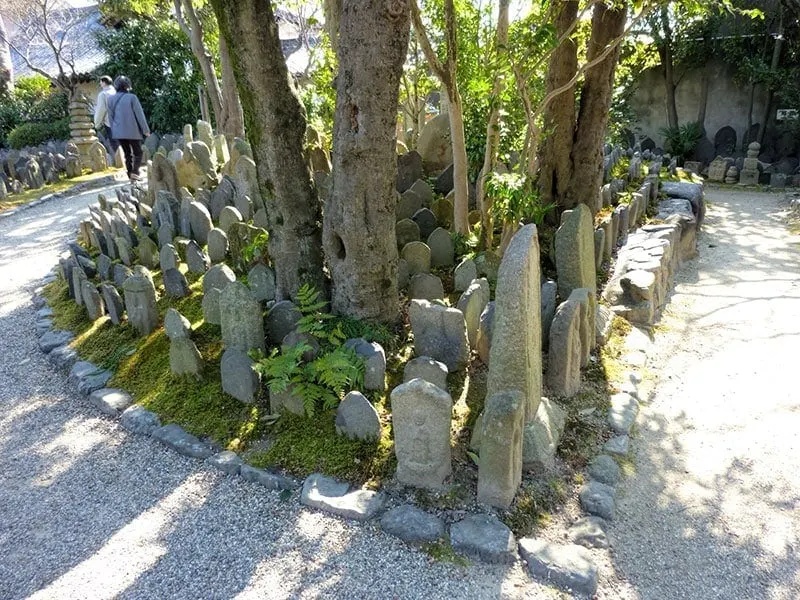
The temple was founded by the powerful Court Minister, Soga no Umako, in 593 after being authorised by Emperor Shushin. This makes it among the oldest temples in Japan. It was originally located at Asuka-Dera and was moved to its present location in Nara town (Naramachi) in 710. In recognising this history some locals still refer to Gango-Ji temple as Asuka of Nara.
The Zenshitsu hall at the rear is now all that remains of the original temple buildings. You can see part of it here as the monks make their way to the main temple for the prayer service ahead of the Setsubun celebrations.
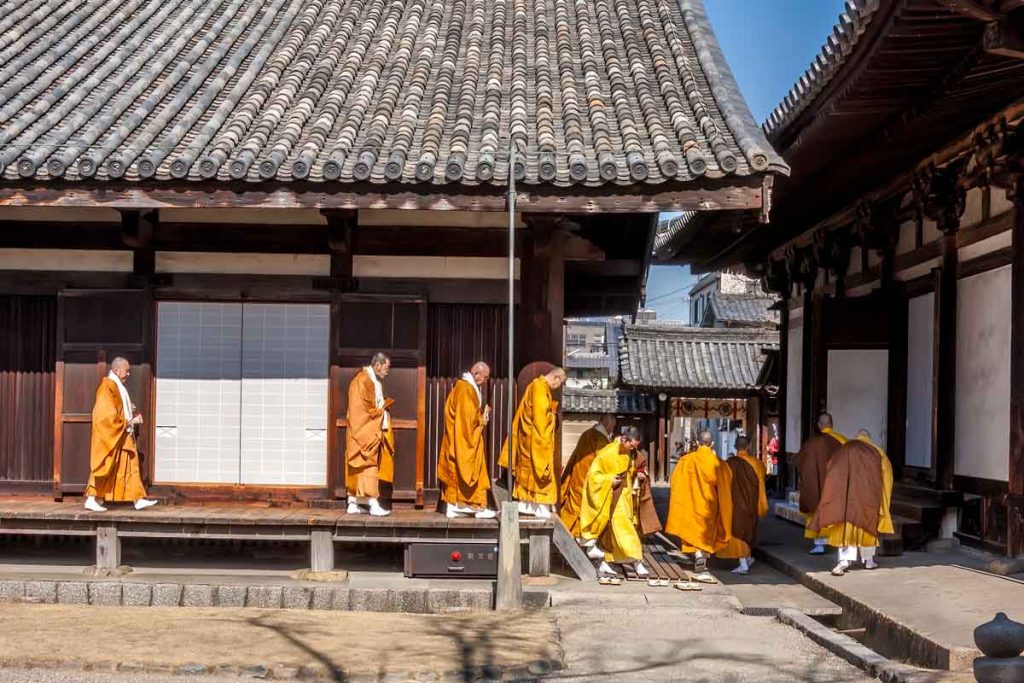
The Buddhist service began and the crowds started growing outside around the area where the day’s festivities would take place from around 3 pm. I wandered to the side of the temple to enjoy the chanting of the service and was invited to go inside and participate.
Fortunately, I joined a little late as the Japanese tradition of kneeling for the service rather than sitting cross-legged, as I normally would for meditation, takes some adjusting too and I could barely stand up when it was over. I’m sure there was no blood left in my numb legs, not even enough to sustain that pins and needles feeling after a while.
There’s a whole range of activities that take place after the service but we stayed for only a few as there were other activities all around Nara for Setsubun that we also wanted to check out. After the Sangha filed out of the hall and were seated comfortably the martial arts began.
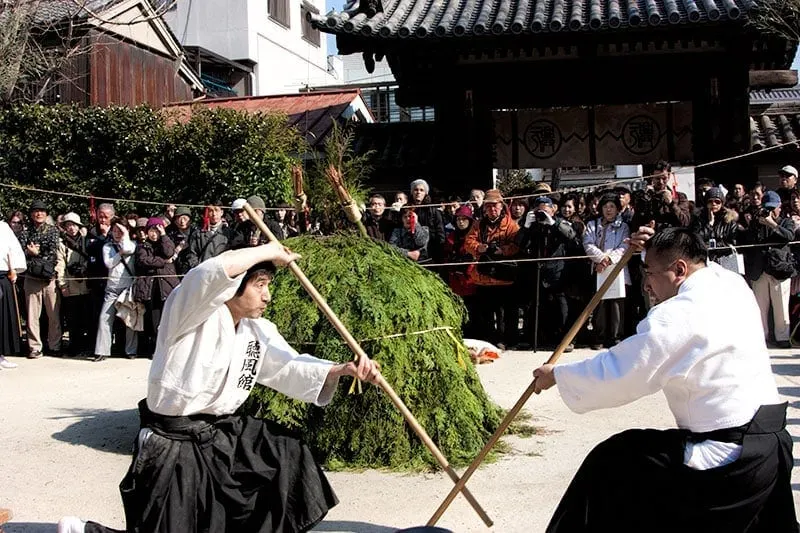
Next was the lighting of the bonfire. This was a mixture of ceremony and theatre, as scrolls were chanted and the bonfire mound, then the four directions, were addressed with a sword and then bow and arrows before the fire was finally solemnly lit.
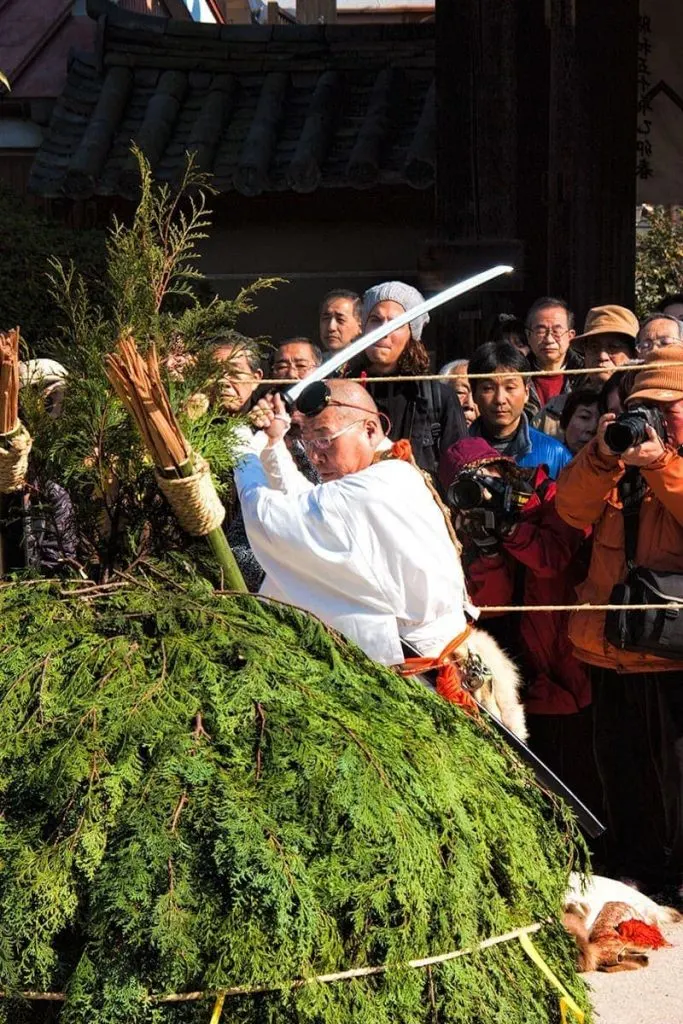
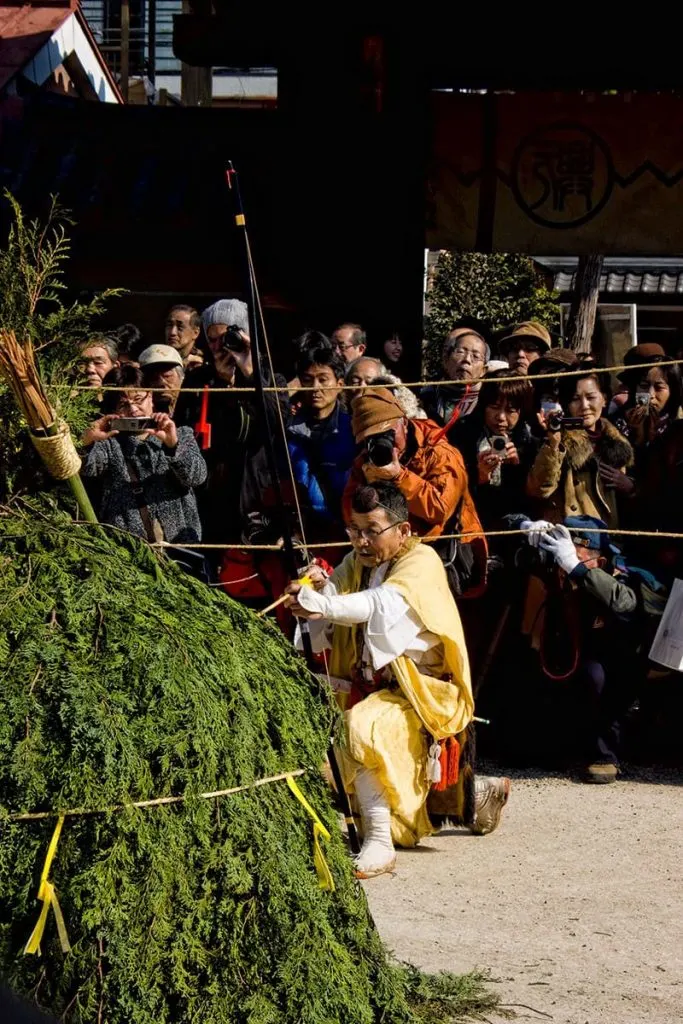
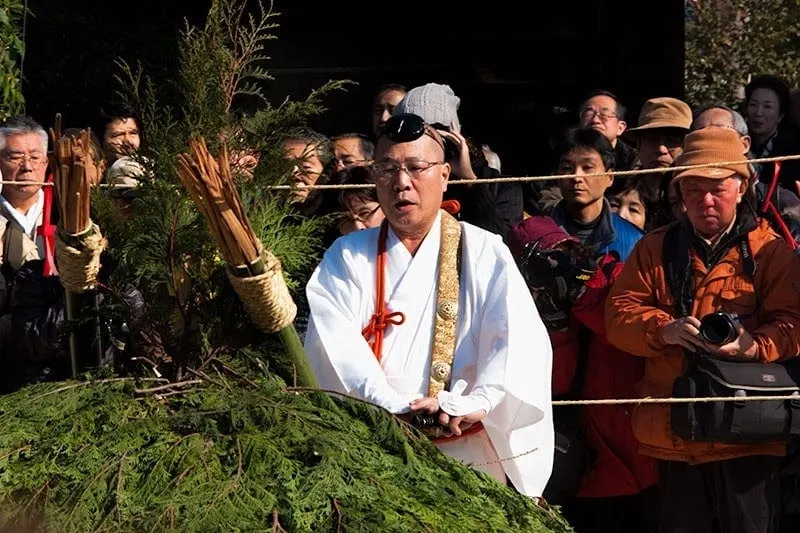
As expected when you light a giant mount of tightly packed, fresh, green cypress pine it creates a lot of smoke but the show must go on.
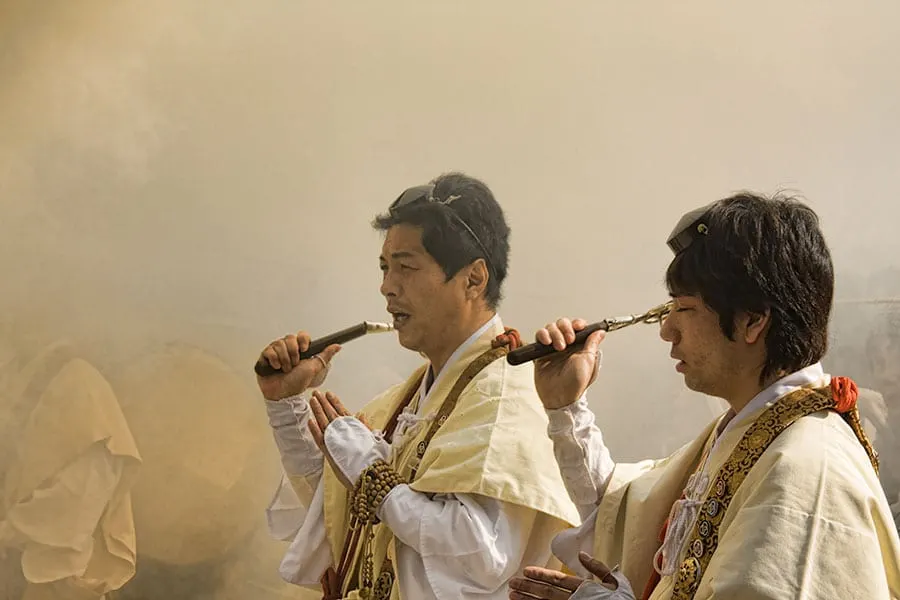
The smoke might smell quite nice but after a few minutes, it still makes your eyes sting and breathing a bit difficult so that was a good time to move upwind and accept a cup of the sake and snacks being offered from the large cask that had been cracked for the occasion.
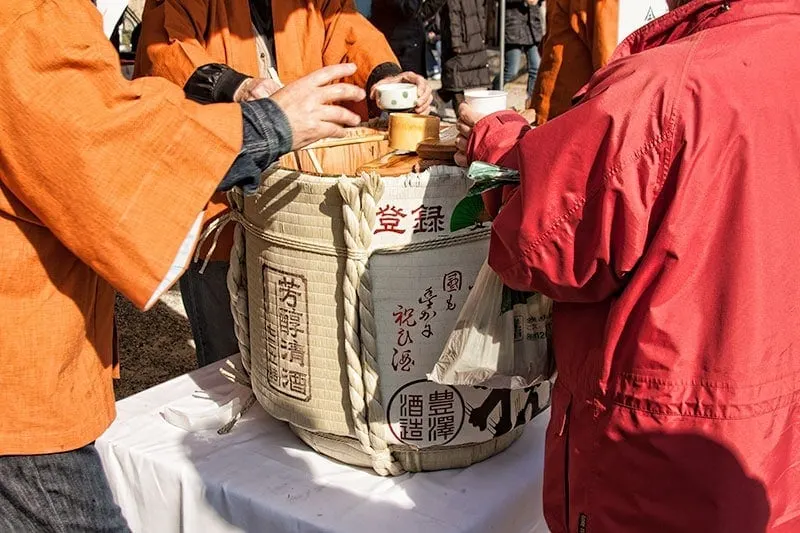
Oh my goodness, that would have to go on the list as one of those things you must do once but I’m not entirely sure I would do again in a hurry. It was STRONG! Still, when the Japanese words to politely decline something desert you in your time of need there’s not much choice. Kampai!
At some point in the celebrations, firewalking was on the agenda but with flames still jumping way taller than me it looked like it would be some time away so we headed off to explore other parts of Nara city and find something to eat before the Setsubun evening activities got underway.
If you like the look of Gango-ji or you’re thinking of visiting Nara you might also want to read up on more things to do in Nara or why we absolutely love our time spent in Nara! for some extra things to see and do while you’re there. Nara is a great city to explore at a more leisurely and relaxed pace and small temples like Gango-ji embedded in the urban landscapes are just one of those reasons.
If you’ve been to Gango-ji or to Nara let me know what you thought in the comments below. I love local festivals like this one at Gango-ji and always try to identify one or two to add to our itinerary when we travel.
Norman
Sunday 26th of April 2015
Haha - you call it templed out and i call it the Shrine Sickness ;-) so easy to get in the greater region of Nara/Kyoto.
In my opinion that ilness really doesn't exist - however u do have to time your visits a bit. Most Japanese temples and shrines will have spectacular festivals throughout the year (like your report clearly shows). These are almost always amazing.
Vicky and Buddy
Tuesday 14th of April 2015
What a lovely experience. I thought it was interesting how in the beginning you said many people were "templed out" and that you could never relate. I had a similare experience in Europe but with churches. My ex-husband would said he was "churched out" and would just sit in a pew while I continued to meander around and take it all in. Not everyone gets it the way we do ;)
Valerie
Monday 13th of April 2015
I have been hearing so much about Japan lately, I must visit there soon! What great timing though being there for the celebration! That would definitely make it extra special I think, seeing how much it means to everybody there celebrating.
Andrea
Monday 13th of April 2015
Though the smoke was a little overwhelming I can imagine just how amazing it would be to experience such a ceremony and cultural rite!
Alli
Monday 13th of April 2015
I'd love to watch a Buddhist service like that. So special! I hope I can get to Japan soon! I'd love to visit Nara, it just looks so sweet, quaint, and beautiful.